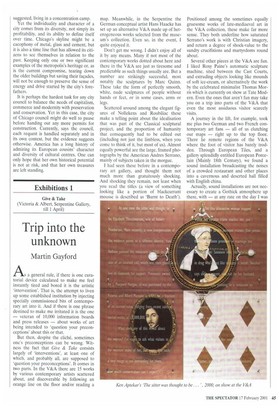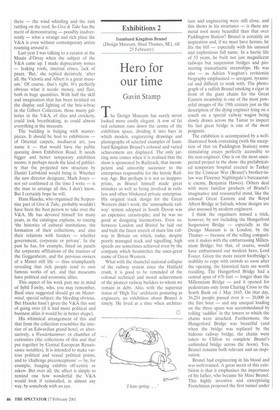Give & Take
(Victoria & Albert, Serpentine Gallery, till 1 April)
Trip into the unknown
Martin Gaylord
As a general rule, if there is one curatorial device calculated to make me feel instantly tired and bored it is the artistic 'intervention'. That is, the attempt to liven up some established institution by injecting specially commissioned bits of contemporary art into it. And if there is one phrase destined to make me irritated it is the one — veteran of 10,000 information boards and press releases — about works of art being intended to 'question your preconceptions' about this or that.
But then, despite the cliché, sometimes one's preconceptions can be wrong. Witness the fact that Give & Take consists largely of 'interventions', at least one of which, and probably all, are supposed to 'question your preconceptions'. It comes in two parts. In the V&A there are 15 works by various contemporary artists scattered about, and discoverable by following an orange line on the floor and/or reading a
map. Meanwhile, in the Serpentine the German conceptual artist Hans Haacke has set up an alternative V&A made up of heterogeneous works selected from the museum's collection. Even so, in the event, I quite enjoyed it, Don't get me wrong. I didn't enjoy all of it by any means. Many if not most of the contemporary works dotted about here and there in the V&A are just as tiresome and predictable as such things usually are. But a number are strikingly successful, most notably the sculptures by Marc Quinn. These take the form of perfectly smooth, white, nude sculptures of people without hands or feet, or in some cases, arms or legs.
Scattered around among the elegant figures of Nollekens and Roubiliac these make a telling point about the idealisation that was part of the Classical sculptural project, and the proportion of humanity that consequently had to be edited out (including not just the limbless, when you come to think of it, but most of us). Almost equally powerful are the large, framed photographs by the American Andres Serrano, mainly of subjects taken in the morgue.
I had seen these before in a contemporary art gallery, and thought them not much more than gratuitously shocking. And shocking they remain, not least when you read the titles (a view of something looking like a portion of blackcurrant mousse is described as 'Burnt to Death'). Positioned among the sometimes equally gruesome works of late-mediaeval art in the V&A collection, these make far more sense. They both underline how saturated Serrano's work is with Christian imagery, and return a degree of shock-value to the sundry crucifixions and martyrdoms round about.
Several other pieces at the V&A are fun. I liked Roxy Paine's automatic sculpture machine, sited between the Cast Courts, and extruding objects looking like mounds of soft ice-cream, or alternatively the work by the celebrated minimalist Thomas Morris which is currently on show at Tate Modern. Even the ones that aren't fun may take you on a trip into parts of the V&A that even the most assiduous visitor scarcely visits.
A journey in the lift, for example, took me plus two German and two French contemporary art fans — all of us clutching our maps — right up to the top floor. There lie remote regions of the V&A where the foot of visitor has barely trodden. Through European Tiles, and a gallery splendidly entitled European Porcelain (Mainly 18th Century), we found a sound installation broadcasting the noises of a crowded restaurant and other places into a cavernous and deserted hall filled with English china.
Actually, sound installations are not necessary to create a Gothick atmosphere up there, with — at any rate on the day I was there — the wind whistling and the rain rattling on the roof. So Give & Take has the merit of demonstrating — possibly inadvertently — what a strange and rich place the V&A is even without contemporary artists roaming around it.
Last year I was talking to a curator at the Musee d'Orsay when the subject of the V&A came up. I made deprecatory noises — leaking roofs, internal crises, lack of pzazz. 'But,' she replied decisively, 'after all, the Victoria and Albert is a great museum.' Of course, that's right. It's perfectly obvious what it needs: money, and flair, both in huge quantities. With half the skill and imagination that has been lavished on the display and lighting of the bric-a-brac in the Gilbert Collection, those musty galleries in the V&A, of tiles and crockery, could look breathtaking, as could almost everything in the museum.
The building is bulging with masterpieces. It should be host to exhibitions — of Oriental carpets, mediaeval art, you name it — that would have the public queuing down Exhibition Road. It needs bigger and better temporary exhibition rooms; it perhaps needs the kind of publicity that the projected new structure by Daniel Liebskind would bring it. Whether the new director designate, Mark Jones — not yet confirmed at the time I write — is the man to arrange all this, I don't know. But I certainly hope he will.
Hans Haacke, who organised the Serpentine part of Give & Take, probably wouldn't have been the best person to take over the V&A. He has devoted himself for many years, as the catalogue explains, to tracing 'the histories of cultural institutions, the formation of their collections, and also their relations with funders — whether government, corporate or private'. In the past he has, for example, listed on panels the corporate affiliations of the trustees of the Guggenheim, and the previous owners of a Manet still life — thus triumphantly revealing that rich people tend to own famous works of art, and that museums have political and economic allies.
This aspect of his work puts me in mind of Sybil Fawity, who, you may remember, Basil once suggested should go on Mastermind, special subject: the bleeding obvious. But Haacke hasn't given the V&A this sort of going over (if it had more political and business allies it would be in better shape).
His whimsical arrangement of this and that from the collection resembles the interior of an Edwardian grand hotel, or alternatively, a Wunderkammer, or chamber of curiosities (the collections of this and that put together by Central European Renaissance notables). It is intended to make various political and sexual political points, and to 'challenge preconceptions' — by, for example, hanging exhibits off-centre or askew. But over all, the affect is simply to remind one how wonderful the V&A would look if reinstalled, in almost any way, by somebody with an eye.



































































 Previous page
Previous page